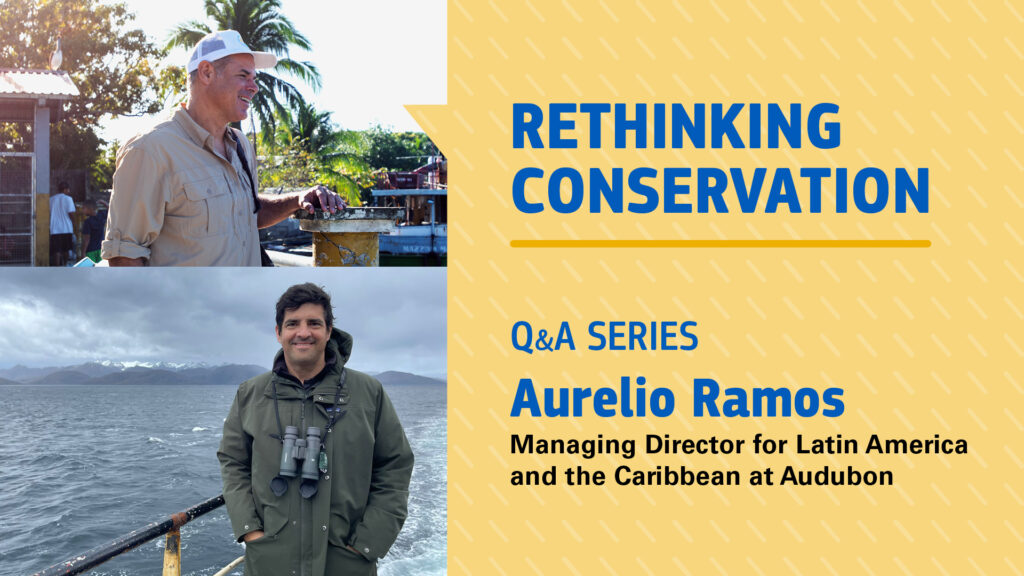
Conserva Aves is advancing a new conservation model — one that prioritizes permanence, centers local communities, and scales across a hemisphere. We spoke with Aurelio Ramos, Managing Director for Latin America and the Caribbean at Audubon, about what it takes to embed equity and longevity into conservation at scale.
Part of Rare’s Rethinking Conservation series, this conversation builds on the need to view people as central to solving the biodiversity and climate crises. Through discussions with forward-thinking experts, the series explores innovative strategies and collaborative solutions that empower communities, advance conservation, and redefine our relationship with nature.
Caleb: Conserva Aves is an incredible conservation partnership model. Tell us more about it.
Aurelio: Conserva Aves is a partnership among American Bird Conservancy, Audubon, BirdLife International, Birds Canada, and RedLAC (the Network of Environmental Funds of Latin America and the Caribbean). Our initial goal is to support local communities and organizations in protecting and sustainably managing their territories — promoting their well-being and the conservation of 2 million hectares of critical habitat for birds, biodiversity, and the planet. It is an initiative funded by the Bezos Earth Fund (BEF), Global Affairs Canada (GAC), and other donors.
Today, we have a network of over 65 organizations — international, national, regional, and local — supporting local organizations to ultimately manage 130 protected areas covering more than 2 million hectares across nine countries in the Americas. This ecosystem of organizations, with clearly defined roles and a common goal, ensures long-term conservation outcomes.
We’re not just creating new protected areas; we’re investing in the local people who will steward them long into the future.
Caleb: The partnership seeks permanent protection for 2 million hectares — but what does “permanence” really mean in practice? How are you building long-term conservation rooted in local leadership, and what needs to change in the traditional donor-driven model to make this possible?
Aurelio: The success of Conserva Aves lies in its flexibility and commitment to adapting to local contexts. Unlike traditional top-down approaches, our model prioritizes local community-based and municipal organizations as the leaders of the process. Strategic technical and financial support is tailored to their needs.
Our initial support typically spans four years. It’s designed to give local organizations a strong start and build the momentum needed to sustain their efforts. In collaboration with our Conserva Aves consortium partners, we focus on strengthening governance, covering the costs of legal declarations, developing management and business plans, setting up monitoring systems, and making catalytic investments that help leverage additional funding.
The goal is to equip local organizations and communities with the skills and resources they request to manage their territories long-term. We’re also beginning to secure resources that will ensure permanent protection and management of these areas.
Permanence doesn’t come from a legal designation alone — it comes from local ownership, trusted partnerships, and ongoing investment.”
Caleb: You’ve spoken about building a hemispheric conservation movement. What does scale look like in human terms, not just in hectares protected?
Aurelio: Conservation can only happen with people — by engaging and empowering committed local communities who benefit from these efforts. Birds, especially migratory species, connect these communities and the critical sites they inhabit with the rest of the hemisphere. I believe we can build community based on this connectivity.
In essence, birds show us the way. They greet us every morning with their songs. We see them on our way to work, at the park, or while working outdoors. Colorful and charming, they fill our skies and landscapes with life. Over the past decade, public interest in birds has grown significantly — especially among young people. In the U.S. alone, it is estimated that 96 million people consider themselves bird enthusiasts.
This is why we at Audubon give birds a voice — so they can inspire action on today’s most urgent environmental issues and solutions. The “movement” begins with birds. Our goal is to engage both urban and rural communities in meaningful individual and collective solutions.
And as we harness public enthusiasm, we will also build a strong economic case for conservation. Demonstrating the economic value of biodiversity is essential to strengthening local and regional protections.

Caleb: We know monitoring and evaluation often fall through the cracks in large-scale conservation. How are you embedding learning and adaptation as core functions, not afterthoughts? And what role can behavioral insights play in making that work?
Aurelio: What is not known and measured cannot be managed or improved. That’s why monitoring and evaluation are essential from the start and are resourced across all Conserva Aves projects.
In collaboration with our Conserva Aves partners, we have developed a hemispheric dashboard that brings all the information together for public and local access. One of the most innovative aspects is that we are beginning to use acoustic monitoring powered by artificial intelligence. This data is transformed into an index that supports local decision makers to manage their protected areas more effectively.
Importantly, this monitoring and evaluation is carried out by the communities themselves. Recognizing Community Science as a pillar of sustainability helps us honor communities’ contributions in real time. This is key to our goal of connecting territories and people while elevating impact.
Caleb: If you could change one deeply held assumption in the global conservation field — one belief that’s holding us back from scaling sustainability — what would it be, and how would you replace it?
Aurelio: There is a persistent belief that local leadership and scalability are incompatible. I think that’s a false choice. The key is to create flexible, adaptable models that are tailored to local realities but grounded in shared values among all stakeholders.
When models are built this way, they can be replicated, evaluated, and refined. This is precisely what Conserva Aves is working to achieve: local-first conservation that’s scalable, measurable, and built to last.
You don’t scale by imposing; you scale by co-creating and adapting with consistency and care.
Follow Caleb McClennen on LinkedIn for more insights into Rethinking Conservation.